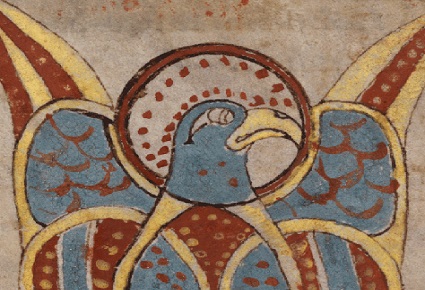Today we look at two Irish saints of the middle 7th century who both went by the name of Crónán: St. Crónán of Roscrea and St. Crónán Mochua, also called Crónán mac Becain. Both were contemporaries.
St. Crónán of Roscrea
St. Crónán of Roscrea came from obscure origins in the region of Munster. Not much is known about his youth other than that he seems to have dwelt in Connacht for sometime before returning to his home district around 610, when he probably entered monastic life, as he founded the Loch Cre abbey shortly after his return. However, the location of Loch Cre was so remote, so wild, and so challenging due to its marshy conditions that St. Crónán shortly abandoned it and began again at a place called Roscrea in Tipperary, with which his name would ever be associated.
While many miracle are attributed to St. Crónán, the details of his life are clouded in obscurity; it is not even certain whether he was a bishop, as some records refer to him as “Bishop of Nendrum” while others mention him only as Abbot of Roscrea.

St. Crónán is most remembered for commissioning one of the most marvelous illuminated editions of the Gospels of the Irish golden age, the Evangelistarium, the so-called “Book of Dimma.” According to tradition, St. Crónán directed one of his monks, a brother named Dimma, to make an illuminated copy of the Four Gospels for use at Roscrea. There are stories of a miraculous extension of daylight for forty days so Dimma could complete the work. Whether or not the composition of the book was attended by any miracles, the Book of Dimma has survived the ravages of time and remains one of the finest examples of Celtic Christian illuminations of the first millennium. The gilded case that originally contained the Book of Dimma dates from the 12th century and has also survived.
It is unknown how long St. Crónán served as Abbot of Roscrea, but the Bollandists put his death around 640. His feast is celebrated on April 28th.
St. Crónán Mochua
Our second Crónán is St. Crónán Mochua, who born around 597 and descended from the famous Irish High King Lugaid. Despite his royal lineage, St. Crónán was not well esteemed by his family, for he suffered from some sort of illness which made the hair on his head fall out in patches. By a chance meeting he was noticed by the great St. Comgall, founder and abbot of the important monastery of Bangor in northern Ireland, who pitied the lad and took him under his care.
St. Crónán grew in piety from his saintly master and himself became devoted to prayer, often spending extended periods alone in tears praying to God; one famous story relates how a barren woman who caught and drank some of his tears was able to conceive. After some time, he left the care of Comgall and passed through the district of Armagh, working many miracles and founding a monastery at Gael. He eventually settled in the region of Connacht where he founded the sanctuary of Balla. This became a particularly important center of Irish Catholicism, and an entire settlement grew up around Balla, which later gave its name to the diocese of Balla (later incorporated into Tuam). According to his Vita, the name Balla means “the wall” and has reference to a wall built around a miraculous fountain which sprung up when Crónán decided to abide at the place.
The nature of the early sanctuary at Balla is unknown. Given that Crónán had many followers, it is presumed to have been a monastery; then again, contemporary records seem to speak of it more as a hermitage, and Crónán was apparently walled up there for a time in solitude. The place subsequently became a place of pilgrimage, as is attested by the ruins of a twelfth church and tower which can still be seen there. Parishes and cemeteries eventually had to be consecrated in the region for the amount of conversions and people flocking to the sanctuary, such that bishops had to be consecrated. Eventually, the region became established as the Diocese of Balla (later merged into the Diocese of Tuam).

St. Crónán abode at Balla for twenty-one years and worked many miracles, some of which are no doubt of a legendary nature. Even so, the sheer amount of miracles recorded of the man must preserve a core truth and St. Crónán of Mochua was certainly a thaumaturgist on par with Patrick or Columba.
St. Crónán Mochua died in 637 on March 30, which is also his feast day.
Phillip Campbell, “Crónán & Crónán,” Unam Sanctam Catholicam, Sept. 5, 2014. Available online at https://unamsanctamcatholicam.com/2023/09/cronan-cronan/

